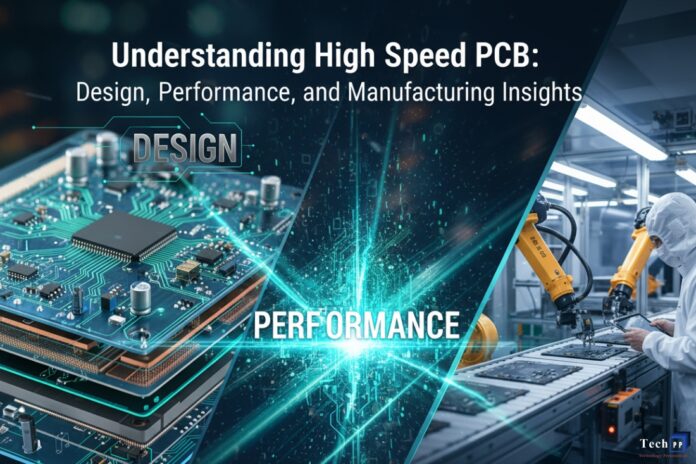In the modern electronics industry, where rapid data transmission and advanced signal integrity are crucial, the High Speed PCB stands out as a vital component. These printed circuit boards are specifically engineered to handle high-frequency signals and fast data rates without interference or signal loss. As technology continues to evolve, High Speed PCBs play a central role in applications like telecommunications, data centers, automotive radar systems, aerospace instruments, and high-performance computing.
Unlike traditional circuit boards, a High Speed PCB demands precision in layout, materials, and manufacturing processes. Even the smallest design variations can significantly impact performance, making it essential to understand their structure, functionality, and production challenges.
What Is a High Speed PCB?
A High Speed PCB is a type of printed circuit board designed to transmit signals at very high frequencies, typically in the range of hundreds of megahertz (MHz) to several gigahertz (GHz). These boards are used in electronic devices where timing, impedance, and signal integrity are critical for optimal performance.
Signal speed on a PCB is directly influenced by the dielectric material, trace width, and layer stack-up. In high-speed circuits, electromagnetic interference (EMI), crosstalk, and impedance mismatches can distort signals, leading to performance degradation. Therefore, engineers must use advanced simulation tools and manufacturing precision to maintain signal quality.
Key Features of High Speed PCBs
1. Controlled Impedance
One of the most defining characteristics of a High Speed PCB is controlled impedance. Impedance control ensures consistent signal flow throughout the circuit, preventing reflections and distortion. Manufacturers achieve this by carefully selecting materials and controlling trace geometry.
2. Multilayer Stack-Up
Most High Speed PCBs are multilayered to separate power and ground planes from signal layers. This layered configuration helps in minimizing electromagnetic interference and allows for compact designs with optimal signal routing.
3. Advanced Materials
The substrate material used in High Speed PCBs plays a crucial role in determining the signal transmission speed. Materials such as Rogers, Taconic, and Isola laminates are preferred due to their low dielectric constant (Dk) and minimal dissipation factor (Df). FR-4, though widely used, may not be ideal for very high frequencies unless enhanced with special formulations.
4. Differential Pair Routing
High Speed PCB design often includes differential pair routing — where two traces carry equal and opposite signals. This configuration minimizes noise and improves data transmission quality, especially in high-speed interfaces like USB, HDMI, and Ethernet.
5. Signal Integrity and Power Integrity
Signal integrity (SI) and power integrity (PI) are key concerns in High Speed PCBs. Improper design can cause jitter, timing errors, or unwanted coupling between signals. Engineers use simulation software to model and correct potential issues before production.
Design Considerations for High Speed PCB
1. Trace Length Matching
Timing is critical in high-speed circuits. If trace lengths differ between differential pairs or data lines, signal skew occurs, leading to timing mismatches. Careful length matching ensures that all signals arrive simultaneously at their destination.
2. Via and Return Path Optimization
Vias can disrupt signal paths and introduce unwanted impedance. Therefore, engineers must minimize via usage or employ back-drilling techniques. Proper return paths also help maintain low noise and consistent impedance.
3. Crosstalk Reduction
Crosstalk occurs when one signal line interferes with another due to electromagnetic coupling. Designers reduce this by maintaining adequate spacing between high-speed traces or routing them orthogonally on adjacent layers.
4. Ground Planes and Shielding
Ground planes act as reference layers that provide a stable return path for signals. Shielding techniques such as ground stitching vias and copper pours help suppress EMI and ensure better signal performance.
5. Layer Stack-Up Planning
An optimized layer stack-up is vital for balancing impedance, minimizing EMI, and ensuring design reliability. The number of layers is determined by signal complexity and frequency requirements.
Applications of High Speed PCB
The demand for High Speed PCBs continues to grow across industries that require reliable and high-frequency signal transmission. Common applications include:
- Telecommunications: Used in routers, switches, and 5G infrastructure for rapid data exchange.
- Automotive Systems: Critical for radar, LiDAR, and advanced driver-assistance systems (ADAS).
- Aerospace and Defence: Ensures precise control and data accuracy in avionics and radar systems.
- Medical Electronics: Used in imaging devices, diagnostic systems, and monitoring equipment.
- Consumer Electronics: Powers high-speed devices like laptops, gaming consoles, and smartphones.
Manufacturing Challenges in High Speed PCB Production
The production of High Speed PCBs involves tight tolerances and advanced fabrication technologies. Some of the major challenges include:
- Material Selection: Choosing the right laminate to balance cost and performance.
- Precision Etching: Achieving accurate trace widths and spacing to maintain controlled impedance.
- Thermal Management: Managing heat dissipation in high-frequency circuits.
- Quality Control: Implementing advanced inspection techniques such as X-ray analysis and time-domain reflectometry (TDR) testing.
Modern High Speed PCB fabrication often uses laser drilling, automated optical inspection (AOI), and impedance testing to ensure flawless results.
Testing and Quality Assurance
Testing plays an essential role in High Speed PCB manufacturing. Electrical testing ensures continuity and proper signal transmission, while impedance testing confirms design accuracy. Environmental and stress tests are conducted to assess the board’s performance under various temperature and humidity conditions.
Future of High Speed PCB Technology
As technologies such as 5G, artificial intelligence, and IoT continue to advance, the demand for High Speed PCBs will only increase. The future points toward hybrid materials, embedded components, and flexible high-speed boards that enable even faster data transfer and miniaturized device designs.
Manufacturers are also focusing on eco-friendly materials and advanced fabrication techniques to meet sustainability goals without compromising performance.
Conclusion
The High Speed PCB represents the heart of next-generation electronics — driving innovation, connectivity, and performance across industries. Its design and manufacturing require advanced technical expertise, precision engineering, and stringent quality control.
For businesses seeking reliable production and exceptional performance, partnering with an experienced High Speed PCB Manufacturer is essential. A trusted manufacturer can provide expert guidance in material selection, impedance control, and testing, ensuring that every board meets the highest standards of speed, stability, and durability.
With the right High Speed PCB partner, you can achieve faster product development, reduced signal losses, and optimized performance for even the most demanding electronic applications.


